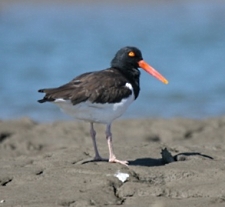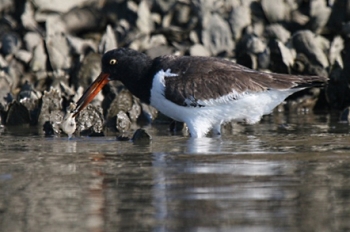Wildlife - Species




American Oystercatcher (Haematopus palliatus)
Description
The American oystercatcher is one of two species of oystercatchers that breed in North America. Oystercatchers are common to seacoasts in temperate to tropical parts of the world. The head and neck are black, and the wings and back are dark brown with distinct white patches that are visible when the bird is in flight. The breast and belly are white, the bill is bright red, and the legs and feet are a pinkish color.
Average Size
Oystercatchers are large, conspicuous shorebirds (43-53 cm or 17-21 in)
Preferred Habitat
In South Carolina, oystercatchers inhabit sandy or pebbly beaches, mudflats, and the borders of salt marshes.
Range
The American oystercatcher breeds along seacoasts from Baja, California, and Massachusetts southward. Wintering grounds are from North Carolina south to the West Indies and Brazil.
Food Habits
The species' common name derives from its peculiar dietary habits. When the bird finds a gaping oyster, it inserts its long bill inside it, cutting the adductor muscle; the valves can no longer shut, and the oyster is easily obtained. American oystercatchers also feed on other bivalves, such as clams and mussels, snails, barnacles, fiddler crabs, aquatic insects, and sea worms.
Reproduction
In South Carolina, nesting begins in early April and ends in late July. Pairs are very defensive during the nesting season. Territorial displays, such as a breeding pair running side-by-side while lowering their heads and calling loudly, are frequently seen near nesting sites. The nest is a shallow depression on a sandy or shelly beach with little or low vegetation. Pairs typically lay 3 speckled eggs and both parents incubate the nest for one month. Some pairs of oystercatchers will nest again if their nest fails during incubation. Chicks are dependent on adults for food for at least two months after hatching. Oystercatcher chicks are able to fly at approximately 35 days. They begin breeding at 3 - 4 years.
Gestation
24 to 25 days for 2 - 4 eggs
Species Significance
The U.S. Shorebird Conservation Plan lists the American Oystercatcher as a "Species of High Concern." South Carolina has approximately 400 pairs of nesting oystercatchers, the majority of which nest on mounds of washed oyster shells. The major threats to these birds are overwash of nests, predation of eggs and chicks, disturbance at nesting and roosting sites, and coastal development.
In addition to providing nesting habitat, South Carolina hosts a large population of oystercatchers in the winter. Over 1/3 of the Atlantic coast population, or 3,500 birds spend the winter months in South Carolina. The majority of wintering Oystercatchers can be found in the Cape Romain area of the coast, feeding on intertidal oysters and roosting on shell mounds along bays and along the Atlantic Intracoastal Waterway.
Their numbers have recently increased due to the implementation of protection programs. Oystercatchers are now common in areas where they were absent a few years ago.
Banding and Monitoring
SCDNR has conducted research on oystercatchers for several decades, including nest monitoring, banding and Resighting, and radiotelemetry. SCDNR is part of the American Oystercatcher Working Group. Additional oystercatcher research can be found on their website.
One tool that DNR staff have used to monitor oystercatchers are field readable color bands. These bands have unique codes that can be viewed with binoculars, spotting scope or camera lens.
Publications and Literature
Bull, J. L. and J. Farrand, Jr. 1995. National Audubon Society Field Guide to North American Birds. Eastern Region. The Audubon Society field guide series. Alfred A. Knopf Inc., New York, NY.
Goss-Custard, J. D. (ed.). 1996. The oystercatcher: From individuals to populations. Oxford University Press, Oxford, U.K.
Nol, E., A. J. Baker, and M. D. Cadman. 1984. Clutch initiation dates, clutch size, and egg size of the American oystercatcher in Virginia. The Auk 101:855-867.
Sprunt, A., Jr. and E. B. Chamberlain. 1970. South Carolina bird life. University of South Carolina Press, Columbia, SC.
Species Contact
Felicia Sanders, Project Biologist, SandersF@dnr.sc.gov
